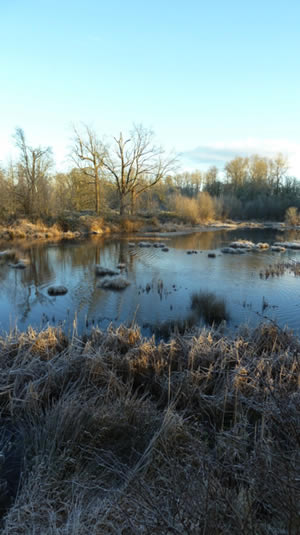Monitoring Methods
Hydrology
- Continuous Water Level
- Continuous Water Quality
- Discrete Water Quality
- Nutrients and Primary Productivity
- Flow and Hydrodynamics
Join the Discussion
Hydrology: Nutrients and Primary Productivity
Nutrients are essential for sustaining marine ecosystems. However, when nutrients, especially nitrogen, are present at excessive levels, eutrophication can occur, leading to algal blooms and oxygen depletion. Anthropogenic sources of nutrients to the Salish Sea include agricultural and stormwater run-off, groundwater seepage, and atmospheric deposition. Nutrient monitoring is an important tool for investigating patterns and drivers of change in nutrient concentrations and can be used in adaptive management decisions for mitigation and remediation strategies (Kennish 2003, Kennish and Townsend, 2007). Chlorophyll a concentration is generally proportional to the amount of phytoplankton, and therefore the overall productivity of estuarine waters and can often be linked to nutrient concentration.

Winter frost, Nisqually NWR
Nutrients measured may include:
- dissolved inorganic nitrogen (NH4+, NO3-, NO2-)
- orthophosphate (PO4-)
- total nitrogen (TN)
- total dissolved nitrogen (TDN)
- total phosphorus (TP)
- total dissolved phosphorus (TDP)
Measurement Methods:
- Measurement can be made at regular intervals (i.e. quarterly) or for specific events (i.e. algal bloom)
- To coordinate with water level data, collect samples at water level logger locations
- For making spatial and temporal comparisons, samples should be collected at the same tide level (i.e. slack high water)
- Surface and bottom measurements should be collected to characterize water quality stratification if it exists
- Grab samples are typically sent to an accredited laboratory for nutrient analysis (i.e. UW Marine Chemistry Lab)
The following are sources of sampling methods:
EPA Nutrient Criteria Technical Guidance Manual – Estuarine and Coastal Marine Waters
Washington State Department of Ecology SOP for Seawater Sampling
Padilla Bay National Estuarine Research Reserve (Puget Sound, WA)
Data Entry and Analysis
Puget Sound Ecosystem Monitoring Program Marine Water Quality Monitoring Work Group
Number of links to web sites relevant to marine water quality in Puget Sound
References
Kennish, M.J. (editor). 2003. Estuarine Research, Monitoring, and Resource Protection. Boca Raton, Florida: CRC Press, 297p.
Kennish, M.J., and A.R. Townsend. 2007. Nutrient enrichment and estuarine eutrophication. Ecological Applications 17(5): S1–S2.
National Estuarine Research Reserve System (NERRS). 2004. Nutrient and chlorophyll monitoring program and database design. Technical Report, NOAA/NERRS Nutrient Monitoring Committee, National Oceanic and Atmospheric Administration, Silver Spring, Maryland.
